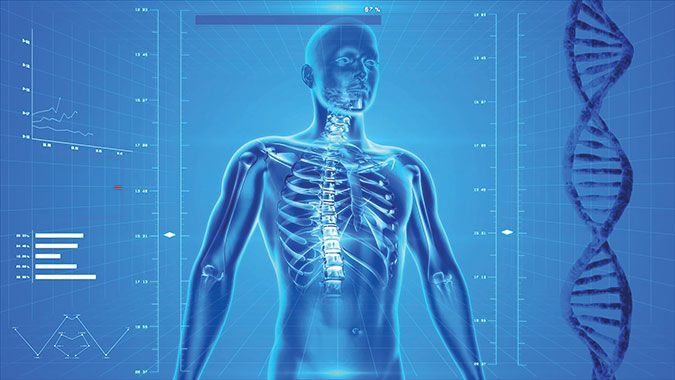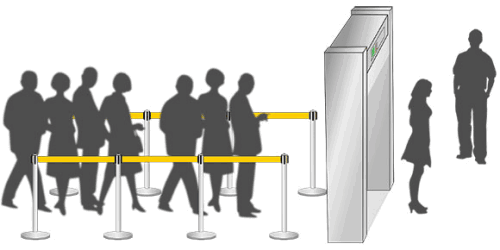

The development of full body low dosage X-rays internationally was initiated in South Africa as part of a system to use X-rays as a means of safely identifying people carrying diamonds internally by De Beers.
Previously, use of medical X-rays meant that dosage had to be carefully controlled with only an occasional scan. By developing low-dosage full body X-rays which used far less electromagnetic radiation, dosage levels could be maintained within Department of Health limits while providing a regular method for detection of contraband carried internally within the body by people.
While not having the resolving power of standard medical X-rays, the ability to see internal objects in the body still allowed detection of contraband, as well as being able to view bone structures and a degree of other body systems. With this capability, the use of a full body X-ray quickly expanded to medical applications such as full body viewing of people involved in accidents and emergency care. At the same time, the worldwide aviation industry was facing major issues in terrorism and the major international goods X-ray manufactures saw opportunities for extending their services and initiated a wave of development at airports and customs. This focus on development has led to a trend of even lower dosage X-rays accompanied by greater resolution and clarity of images.
The use of internal body cavities to smuggle anything from diamonds, gold, platinum and drugs has been a long-term issue. X-ray screening provided one of the first viable strategies to directly address these concerns, and quickly led to savings in locations such as platinum and gold plants. However, there were definite differences in the way the technology was implemented by different users, along with varying successes, and degrees of theft prevention effectiveness. The objective of any full body X-ray system is to facilitate people getting safely through a scanning process as smoothly as possible, with as accurate viewing of the images as possible. In South Africa, the Department of Health has provided strong initial guidance on implementation of the technology and installations are subject to annual reporting and inspections to ensure responsible use.

The X-ray machines themselves are provided in a highly competitive market where there are some differences between makes, but the features and capabilities of the systems are largely similar. Where dosage can be minimised and clarity can be enhanced, those equipment providers will obviously have an advantage. Some variation in equipment, such as having a simultaneous full body as well as chest scan, may also be part of the consideration. The software system to handle the scanning also comes from a variety of distributors with different interfaces and capabilities.
The human factor
While the provision of different image viewing filters is fairly standard, the process of control over the scanning, display and viewing of images, and storage plays a big part in the success of the system. The software interface for the system therefore needs to be carefully considered and chosen, with particular attention on the human use of the interface.
Another key factor in the initial introduction and management is an understanding of X-rays and how they work. From both a management and union point of view, this is essential to the effective introduction, and fortunately the Department of Health Sub-Directorate for Ionising Radiation has been a big factor in facilitating discussions between the parties in this respect. However, the understanding of X-rays is not only relevant to the process of installation and licensing, but also to prevent misconceptions and promote the responsibilities and awareness of the dangers of use.
I‘ve found my training that incorporates how X-rays work, and how both the characteristics of the X-ray and person being screened can change the nature of the image being viewed, are important elements in understanding. It makes personnel responsible for the X-ray process more comfortable with the responsibilities, and also makes them more effective in viewing and analysing images.
The X-ray process
Building an X-ray process has four main concerns. Firstly, to physically integrate it into existing operations and infrastructure. It has to be as close to the source of illegal goods or contraband as possible for protection purposes and needs to be physically integrated with things like entry and exit areas.
Secondly, it has to have ease of use. Having people confused about where to go and what to do is going to create havoc. Besides, during initial implementation there will be some people like visitors or contractors who are unfamiliar with what is supposed to happen, and quite possibly nervous about what they are going through. Clear instructions of what to do while going through the process is important through initial briefings and guides. One of the most important needs is to be able to communicate remotely from the control room via intercom to people so you can tell them what to do and take them through the necessary actions. This is also relevant for experienced people who are not paying attention or simply challenging the system.
Thirdly, the smoothness of flow of people through the X-ray process needs to be facilitated. This means choke points need to be avoided and different scenarios considered to ensure that they don’t happen. Having twenty or thirty people caught up in a plant for an extra hour instead of going home because of a stoppage in scanning people at the exit is a good recipe for a riot.
Fourthly, the entire X-ray process must have integrity. It is there to stop crime, but at the same time criminals will be looking at methods to bypass or compromise the effectiveness of the X-ray process. Indeed, there have been examples of this happening, as well as success stories in catching people. CCTV and effective monitoring of body language that could be linked to theft while going through the X-ray process are an essential part of maintaining the integrity of the process.
Procedures around holding people who have been detected carrying contraband and what to do with them is a necessary component to effectively apprehend the suspect and evidence. It is also recommended that reviewing of both CCTV footage of behaviour, particularly of established suspects, as well as reviewing of X-ray images be done on a regular basis to audit the X-ray process.
The right personnel
Personnel responsible for viewing of the images are typically separated from those who control movement through the X-ray process to ensure that collusion is reduced. Viewing of images needs to be done with speed, accuracy and efficiency to minimise false alarms. In the case of aviation baggage screeners, they have on average five seconds to check a bag for threats and explosives. We find that full body X-rays take appreciably longer, but the better the viewer is at visual analysis, the faster and more accurate they will be.
For example, validation of our selection instruments measuring screener viewing effectiveness at UK airports produced strong correlations with detection rates. The X-ray viewer or screener job definitely demands good skills. Without personnel possessing the right levels of these kinds of core visual analysis skills, even substantial input on training or job management may not lead to the required performance level on the job.
X-ray operators who facilitate people going through the system need to be trained to deal with issues and the system integrity. Similarly, X-ray viewers or screeners don’t have to be radiologists or doctors with an expert knowledge of physical anatomy, but they do have to have an awareness of how items they are looking for are influenced by the body structure, as well as ways of trying to disguise the potential contraband. Training in the background of X-rays, legislation, viewing techniques, and application of skills are all important to successful viewing.
Benefits of automation?
Automated detection for full body X-ray applications, like aviation X-ray baggage screening, has been explored for some time. Despite its increased use, automated detection is likely to be limited in use at this stage. Unlike CCTV, the use of automated detection in X-ray screening can also create additional burdens.
Because the automated algorithms’ performance varies according to scene complexity, in order to achieve a reasonable level of detection, a false alarm rate also needs to be tolerated. In full body X-rays, complications arise because of differences in posture and the way people are standing, compared to a ‘reference image’ that may be used for automated analysis. People have a limited ability to tolerate false alarms within any automated system. This can lead to a breakdown in trust by the operators if it happens too often and the technology is seen as unreliable, a disregard for correctly identified threats which get ignored, or a situation where the operator looks at the area defined by the algorithm while the real target passes unnoticed elsewhere on the image.
Full body low dosage X-rays provide the capacity to evaluate not only what people are carrying below clothing, but also internally within their body. The technology is ideally suited to finding objects that have a metal content of some kind, but has an application in other areas such as drugs and other illegal substances or articles. It needs to be clear though, that low dosage is not equivalent to full strength medical X-rays in the clarity of the image which often already need skilled interpretation.
Nevertheless, low dosage full body X-rays provide a unique and effective means to protect companies and countries from theft and other illegal activities. Concerns about health and safety of X-ray radiation are addressed by strict guidelines from the Department of Health, which is using guidelines firmly rooted in international practice.
However, the X-ray process happens within a greater context of other security systems, company practice, criminal activities, and society. The design and implementation, auditing of integrity, and use of personnel to effectively control the process and identify issues in X-ray images are critical to a successful delivery of the benefits potentially offered by full body X-ray machines. Nevertheless, despite the best technology and implementation, ultimately the determining factor of success is going to be working with people who are going to be affected by X-rays in a socially responsible way. This is in order to alleviate their concerns and overcome common public fears about the potential dangers of X-ray radiation. A coherent strategy to address psychological and social concerns is therefore key to the success of any implementation.

Dr Craig Donald is a human factors specialist in security and CCTV. He is a director of Leaderware which provides instruments for the selection of CCTV operators, X-ray screeners and other security personnel in major operations around the world. He also runs CCTV Surveillance Skills and Body Language, and Advanced Surveillance Body Language courses for CCTV operators, supervisors and managers internationally, and consults on CCTV management. He can be contacted on
| Tel: | +27 11 787 7811 |
| Email: | [email protected] |
| www: | www.leaderware.com |
| Articles: | More information and articles about Leaderware |

© Technews Publishing (Pty) Ltd. | All Rights Reserved.